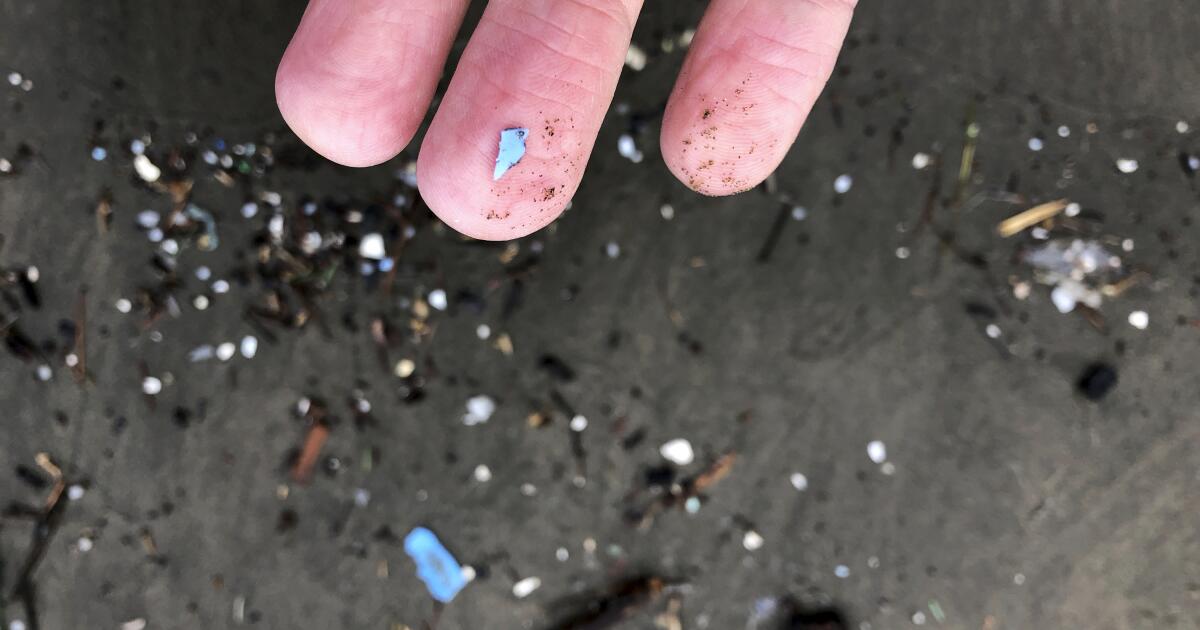I’m Susanne Rust, staff writer for the L.A. Times; I’m filling in for Sammy Roth today.
For the last few months, I’ve been largely covering two topics: Bird flu and plastics. And because bird flu has taken up the majority of my time since it jumped into California’s dairy cattle and dairy workers in August, I’m thrilled to take a moment and examine news in my other major cover area: Plastics!
And there was a doozy of a story published across the media landscape (the New York Times, the Guardian, Smithsonian Magazine, etc.) last week: Bottlenose dolphins living in Florida’s Sarasota Bay and Louisiana’s Barataria Bay not only breathe in plastic when they surface for air, they breathe it out, too.
Researchers found that air samples taken from the playful marine mammals’ blow holes contained plastic polymer fibers and particles — including polyester and polyethylene terephthalate, or PET (the plastic used to make water bottles, string cheese wrappers and microwavable food trays).
Goes without saying, dolphins are not eating their food from these single-use plastic food containers — which means they are getting it from our waste, which has a knack for finding its way into our rivers, oceans and air.
Each year, roughly 2 million tons of plastic end up in the world’s oceans.
I suppose it shouldn’t be surprising that researchers found microplastics in dolphin breath. Seems every time scientists look for microplastics, they find it — from the tops of the planet’s highest snowy mountains and clouds to the deepest depths of our oceans and seas. They’ve been found in whales, birds, crops and invertebrates. And they’ve also been detected in our bodies: Breast milk, semen, lung tissue, brain tissue, blood and heart tissue.
And while scientists don’t yet know how — or if — these plastic particles are harming dolphins, they are concerned. Dolphins have large lung capacity and they pull in a lot of air when they inhale, and then hold it there while they swim and hunt underwater.
I learned not too long ago that the planet’s oceans are some of the largest emitters of microplastics into the atmosphere. Seems dolphins are one of the major biological sentinels of our plastic pollution.
Newsletter
You’re reading Boiling Point
Sammy Roth gets you up to speed on climate change, energy and the environment. Sign up to get it in your inbox twice a week.
You may occasionally receive promotional content from the Los Angeles Times.
On that note, here’s what’s happening around the West:
TOP STORIES
From my colleague, Ian James, comes this happy and amazing story of what can happen when conservation strategies succeed: Klamath River Chinook salmon have been spotted in Oregon for the first time in more than a century.
Two months ago, the last of the four decades-old hydroelectric dams along the Klamath River targeted for removal were taken down — opening the river to salmon that had been spawning in those waters for thousands of years before the dams were erected for electrical power.
According to James, biologists with the Oregon Department of Fish and Wildlife announced they found a single fall-run Chinook on Oct. 16 in a tributary upstream from where J.C. Boyle Dam was recently dismantled.
In California, state biologists are also seeing salmon in creeks they hadn’t had access to since the dams were built.
“It’s amazing,” Ron Reed, a Karuk Tribe member and traditional fisherman, told James. “That’s what we’ve prayed for.”
Reed and other Indigenous leaders had been fighting for the opening of the river for decades, arguing the river’s restoration would help struggling salmon populations recover.
And although there’s debate about how effective technologies such as carbon storage will be at slowing greenhouse gas emissions, CalMatters’ Alejandro Lazo reports on a major step in the state’s efforts in this direction.
On Monday, Kern County’s Board of Supervisors unanimously approved a project designed to capture millions of tons of carbon dioxide and inject it into the ground in the San Joaquin Valley.
According to Lazo, the Carbon Terra Vault project, which is run by the California Resources Corp. — the largest producer of oil and gas in the state — is “part of a broader bid by the oil and gas industry to remain viable in a state that is attempting to decarbonize.”
Although the company still faces several hurdles, Monday’s county approval is a crucial first step.
Carbon capture and sequestration are supported by the Newsom administration, and considered a major part of the governor’s action plan to reduce greenhouse gases over the next two decades.
But as Lazo notes, not everyone is happy about this — or these kinds of — project(s).
“Carbon Terra Vault will incentivize new polluting infrastructure throughout Kern County,” Ileana Navarro, a community organizer with the Central California Environmental Justice Network, based in Bakersfield, told the packed county supervisor meeting attendees. “This will not clean our air.”
The oil and gas industry and labor unions say this project and others could preserve jobs in a region where output has slowed and jobs are becoming increasingly scarce. They say it will also ensure that the industry captures and stores more emissions than it emits.
The U.S. Environmental Protection Agency will still have to approve the project. So, too, must the California Air Resources Board.
While gains are being made in some sectors of the green economy, sales of heat pumps are on the decline, according to this story in the Washington Post.
According to the Post’s Shannon Osaka, the reasons: “… a combination of high interest rates, rising costs, misinformation and the cycle of home construction.”
In the last two years, heat pump investments in the U.S. have dropped 4%. In Europe, heat pump sales in 13 countries have dropped nearly in half.
Heat pumps are considered critical for making buildings more climate-friendly. According to Osaka, roughly 60% of American homes are still heated with furnaces fueled by oil, natural gas or propane.
Part of the problem, say experts, is that while the Inflation Reduction Act provides tax incentives for heat pumps, those incentives are targeted at the consumer — not the contractor or installer. As a result, not all contractors and installers offer them.
“In a big part of the northern U.S., there haven’t been really incentives to push people to learn how to do it properly,” Barton James, the president and CEO of the Air Conditioning Contractors of America, told Osaka. “They’re not yet comfortable that it’s actually going to work for the climate.”
POLITICAL CLIMATE
Although the U.S. EPA’s director was quick to recognize the harm caused by lead pipes in Los Angeles’ public housing projects, a new agency order will do little to solve the problem.
That’s because the order “targets lead service lines connecting homes to water mains, it doesn’t address plumbing inside the building that can still pose a risk, such as lead soldering, brass fixtures and interior mains,” wrote Los Angeles Times reporters Tony Briscoe, Ian James and Rebecca Plevin, on the intractable situation.
They say that earlier this month, the EPA’s director, Michael Regan, visited the 700-unit Jordan Downs complex with Mayor Karen Bass. Days later, the environmental agency issued a nationwide order requiring the replacement of lead pipes in drinking water systems within 10 years.
“We’ve known for decades that lead exposure has serious long-term impacts for children’s health. And yet, millions of lead service lines are still delivering drinking water to homes,” Regan said.
According to Briscoe, James and Plevin, lead service lines were banned in 1986. However, roughly 9 million homes nationwide still receive tap water through these aging pipelines.
As these pipes age and corrode, they leach lead — a chemical with no safe level of exposure — into tap water.
“When ingested by children, the heavy metal can cause irreversible brain damage and behavioral issues,” wrote the Times reporters.
AROUND THE WEST
Considered rarities along California’s Central Coast, sperm whales may actually be frequent visitors, new research shows.
Scientists at the Monterey Bay Aquarium Research Institute dropped a microphone 18 miles off the Monterey Coast for seven years. They then searched their recordings for sperm whale vocalizations, or clicks.
While local whale boat operators reported sperm whale sightings to average about once every five years, the scientists heard the rarely seen whales on more than one-third of the days they were recorded between 2015 and 2022.
The microphone was dropped 3,000 feet below water’s surface.
“This is an endangered population of marine mammals. If we want to protect them, we first need to understand where they are,” Will Oesterlich, the lead researcher, told Mark DeGraff of the Monterey Herald.
ONE MORE THING
Because H5N1 bird flu is top of my mind these days, I noted this news story from High Country News, which explores a California program that pays rice farmers to create “pop-up” habitats for migrating birds.
For tens of thousands of years, millions of birds have flown along the Pacific Flyway from their Arctic feeding and breeding grounds in the summer, to the forests and woodlands of North, Central and South America. And for millennia, those birds stopped to rest and feed in the wetlands of California’s Central Valley.
However, in the last century, 95% of those wetlands have been drained to make room for development and intensive agriculture (including the more than 1,000 dairy farms of the San Joaquin Valley, where bird flu is currently running rampant). This has had a detrimental effect on wild bird populations, some of which — including the western sandpiper — are now imperiled.
In 2014, a group of conservation organizations got together to try a new strategy: They paid rice farmers to keep their fields flooded a few weeks more than is typical. Extending the flooded season was a win for those weary-trekking birds — as well as for the farmers, who got to put some extra cash into their pockets.
It’s considered a conservation success story — a rare sighting these days.
This is the latest edition of Boiling Point, a newsletter about climate change and the environment in the American West. Sign up here to get it in your inbox. Or open the newsletter in your web browser here.
For more climate and environment news, follow @Sammy_Roth on X.




